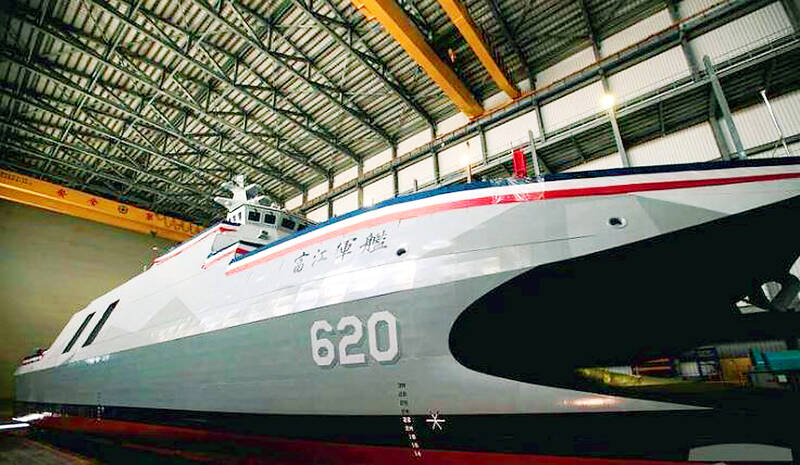The navy is expected to take delivery of the nation’s second domestically built Tuo Chiang-class corvette next month, a military source said yesterday.
The Tuo Chiang-class corvette is a fast, stealthy multipurpose warship designed and manufactured locally for the navy.
A prototype of the corvette named Tuo Chiang (PGG-618) was commissioned in 2015. The first complete Tuo Chiang-class corvette, the Ta Chiang, was launched in December 2020.

Photo courtesy of the Military News Agency
The second corvette, the Fu Chiang, was launched in September last year, while the third, the Hsu Chiang, was launched in February.
The Fu Chiang is to be delivered to the navy some time next month, a military source said, adding that official training would be conducted on the corvette before it is commissioned to the armed forces.
The Tuo Chiang-class corvette has a maximum speed of 30 knots (55.6kph), a displacement of 685 tonnes and an operational range of 1,800 nautical miles (3,334km), the navy has said.
It was developed to address a common weakness of traditional small warships, such as patrol craft and corvettes: They are not fit for use over extended periods of time in the rough seas around Taiwan.
The Tuo Chiang-class corvettes are fitted with subsonic Hsiung Feng-II missiles, supersonic Hsiung Feng-III anti-ship missiles, a 76mm cannon and Tien Chien II air-defense missiles.
The Tuo Chiang is named after a former patrol vessel deployed in defense against Chinese warships in a Taiwan Strait sea battle in 1958.
The Fu Chiang and the Hsu Chiang are named after rivers in Hualien County and Keelung.
Their names were selected following a public vote.
Taiwan plans to build a total of 11 Tuo Chiang-class corvettes by the end of 2026.

TRAGEDY STRIKES TAIPEI: The suspect died after falling off a building after he threw smoke grenades into Taipei Main Station and went on a killing spree in Zhongshan A 27-year-old suspect allegedly threw smoke grenades in Taipei Main Station and then proceeded to Zhongshan MRT Station in a random killing spree that resulted in the death of the suspect and two other civilians, and seven injured, including one in critical condition, as of press time last night. The suspect, identified as a man surnamed Chang Wen (張文), allegedly began the attack at Taipei Main Station, the Taipei Fire Department said, adding that it received a report at 5:24pm that smoke grenades had been thrown in the station. One man in his 50s was rushed to hospital after a cardiac arrest

PUBLIC SAFETY: The premier said that security would be tightened in transport hubs, while President Lai commended the public for their bravery The government is to deploy more police, including rapid response units, in crowded public areas to ensure a swift response to any threats, President William Lai (賴清德) said yesterday after a knife attack killed three people and injured 11 in Taipei the previous day. Lai made the remarks following a briefing by the National Police Agency on the progress of the investigation, saying that the attack underscored the importance of cooperation in public security between the central and local governments. The attack unfolded in the early evening on Friday around Taipei Main Station’s M7 exit and later near the Taipei MRT’s Zhongshan

SAFETY FIRST: Double the number of police were deployed at the Taipei Marathon, while other cities released plans to bolster public event safety Authorities across Taiwan have stepped up security measures ahead of Christmas and New Year events, following a knife and smoke bomb attack in Taipei on Friday that left four people dead and 11 injured. In a bid to prevent potential copycat incidents, police deployments have been expanded for large gatherings, transport hubs, and other crowded public spaces, according to official statements from police and city authorities. Taipei Mayor Chiang Wan-an (蔣萬安) said the city has “comprehensively raised security readiness” in crowded areas, increased police deployments with armed officers, and intensified patrols during weekends and nighttime hours. For large-scale events, security checkpoints and explosives

ON ALERT: Taiwan’s partners would issue warnings if China attempted to use Interpol to target Taiwanese, and the global body has mechanisms to prevent it, an official said China has stationed two to four people specializing in Taiwan affairs at its embassies in several democratic countries to monitor and harass Taiwanese, actions that the host nations would not tolerate, National Security Bureau (NSB) Director-General Tsai Ming-yen (蔡明彥) said yesterday. Tsai made the comments at a meeting of the legislature’s Foreign Affairs and National Defense Committee, which asked him and Minister of National Defense Wellington Koo (顧立雄) to report on potential conflicts in the Taiwan Strait and military preparedness. Democratic Progressive Party (DPP) Legislator Michelle Lin (林楚茵) expressed concern that Beijing has posted personnel from China’s Taiwan Affairs Office to its